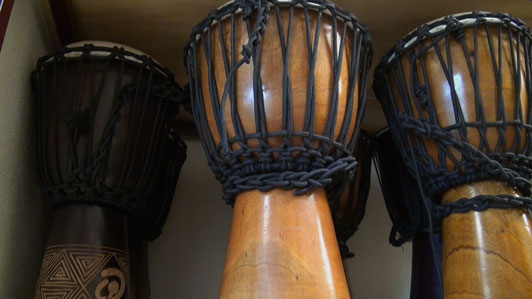
Music
This Music Arts-POP outlines a unit called African Drumming: Making and Responding to Rhythms, Notation and Compositions. This unit engages students in learning about rhythmic notation, composing musical phrases and performing African drumming patterns using real and constructed . A mortar-shaped hand drum, typically made from wood and goat skin. Originating from the west African countries of Mali and Guinea.

Wanguri Primary School, djembe drums.
African Drumming consists of music lessons over six weeks where students compose, notate, perform and record music using digital and information communication technology. Students have the opportunity to create and respond throughout this unit: they construct a small practice djembe; perform together; create and compose a short ostinato (repeating rhythm); compose with musical notation; and practise giving and receiving both positive and constructive feedback. The package aims to illustrate good practice in music education and links current teaching practices with the emerging Australian Curriculum: The Arts at the Year 6 level.
Many teachers, including classroom and music teachers, are currently implementing the Australian Curriculum. They are finding innovative ways to link and adjust their current teaching methods and existing curriculum and reporting cycles to meet national standards. This package provides an example of how one teacher and school approached this challenge. The package also demonstrates a rich opportunity to consider cross-curriculm priorities, and address and assess general capabilities such as Science and technology, Information and communication technology (ICT), Personal and social capability (PSC) and Intercultural understanding (ICU).
Students experience authentic classroom learning throughout this package. They have the unique opportunities to see a music notation system in use by their local community-based orchestra, learn to give and receive positive and constructive feedback from a practising artistic director (here, a classroom visit by a symphony conductor, Dr. Leif Sundstrup), and compose and perform rhythms to accompany their Year 6 graduation song performance.
While becoming familiar with the new curriculum, the participating teacher noted the value of release time for professional learning and development. The value of teacher mentoring and peer observation can be seen throughout this package, as teachers develop their skills to implement the music curriculum. This package also demonstrates how music, like all the arts, can provide useful and authentic contexts for teachers to develop, apply and assess ICT capabilities and digital technology skills.
Implementing the new Australian Curriculum: The Arts and building the necessary skills does not need to be an isolating experience. This package aims to assist generalist and specialist teachers in bringing music into classroom learning.
Information and Communication Technology (ICT) for Learning
Many educational areas have programs in place to enhance teacher capability in ICT. Within the Northern Territory, ICT for Learning enhances the ICT capabilities of teachers through mentoring and programs such as the “Bring your Classroom” initiative (see ICT for Learning – Nightcliff Technology Precinct). In this package, making and responding are directly enhanced through ICT. The arts provide a very useful and authentic context for teachers to develop, apply, and assess ICT capabilities and digital technology skills.